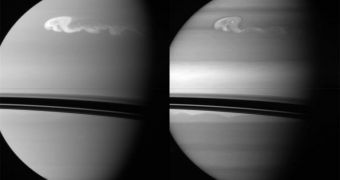The NASA Cassini orbiter has produced new amazing photos of its target planet, the gas giant Saturn, when it managed to observe in detail a massive storm that erupted in the planet's northern hemisphere.
Neighboring planets Saturn and Jupiter both feature complex weather patterns, but the difference between them is that the events are a lot easier to discern in the latter, Wired reports.
On Saturn, a thick and hazy atmosphere is preventing astronomers from taking in-depth looks at storms or cloud movements above the gaseous surface of the planet. This is why it's relatively uncommon for experts to find and analyze storms here.
But the new event was first observed by amateur astronomers, who alerted their professional colleagues about the discovery. This is one of the main reasons Cassini was re-oriented to snap a photo of the weather pattern.
Observations were conducted on Friday, December 24, and the first raw images of the event were made available on Monday, December 27. Science teams operating the spacecraft have not yet had the chance to make the necessary adjustments to the photos.
They show an impressively-large storm, which boasts a head and a detail, as it's spanning over a huge stretch of the Saturnine atmosphere. The image you see here was snapped from a vantage point some 1.1 million miles away.
“This storm had been sighted by the amateurs in recent weeks, but Cassini was finally in a position to take a splendid series of pictures of it. And what a storm it is!” explains scientist Carolyn Porco.
She is the leader of the imaging science team on the Cassini mission, a veteran imaging scientist of the Voyager mission to the outer solar system in the 1980s, and an imaging scientist on the New Horizons mission on its way to Pluto and the Kuiper Belt.
Porco also holds an appointment as the Director of the Cassini Imaging Central Laboratory for Operations (CICLOPS) at the Space Science Institute (SSI), in Boulder, Colorado.
The Cassini science team members are lucky to have had the chance to image the storm. On November 2, the spacecraft experienced a severe glitch, when data sent from Earth were corrupted by a solar flare.
They even saw the orbiter go into safe mode until November 24, when rigorous programming on the part of experts at the NASA Jet Propulsion Laboratory (JPL), who manage Cassini, saw it regaining its full functionality.
Cassini was launched back in 1997, and spent the next seven years en route to its destination. It achieved orbital insertion around Saturn on July 1, 2004, and has been surveying the gas giant, its atmosphere, its rings and its moons ever since.

 14 DAY TRIAL //
14 DAY TRIAL //